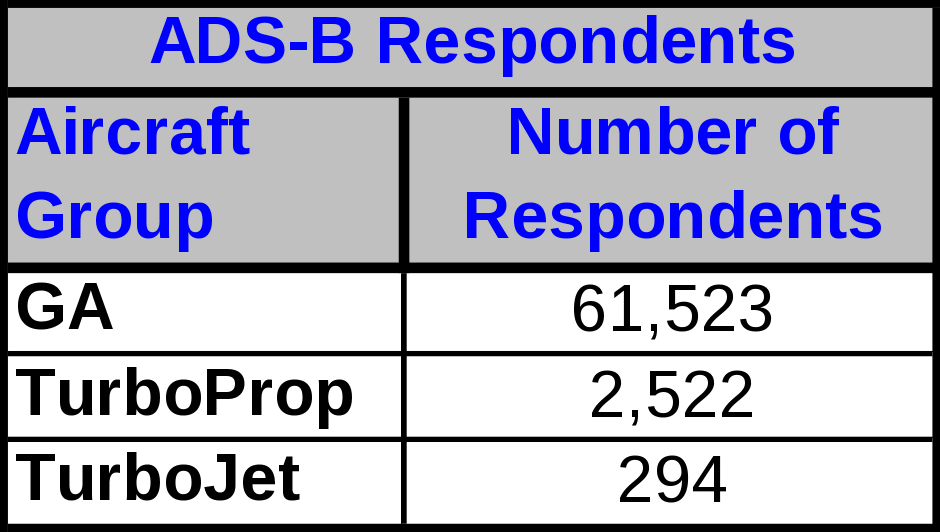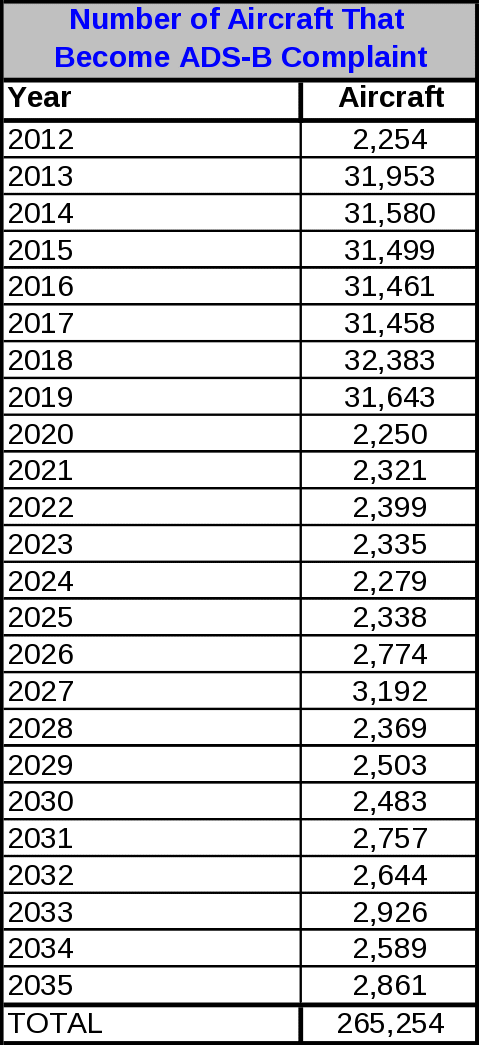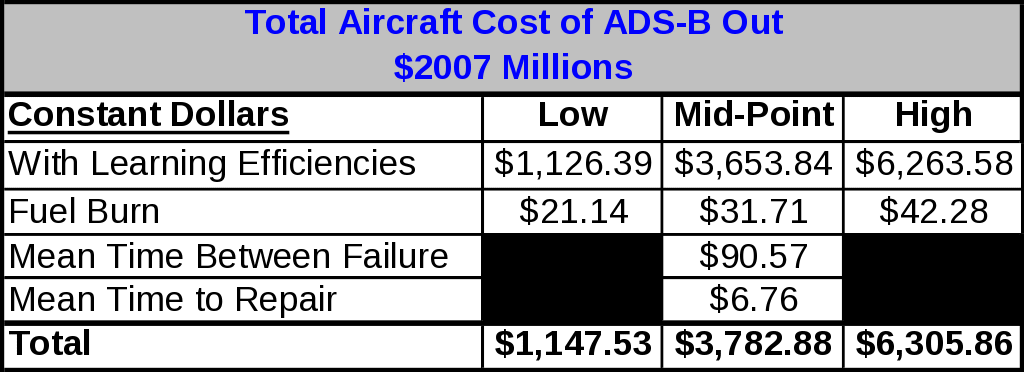2120-ads-b Nprm
2120-ADS-B NPRM.DOC
Automatic Dependent Surveillance Broadcast (ADS-B) Out Performance Requirements to Support Air Traffic Control (ATC) Service
OMB: 2120-0728
INFORMATION COLLECTION SUPPORTING STATEMENT
AUTOMATIC DEPENDENT SURVEILLANCE – BROADCAST (ADS-B) OUT PERFORMANCE REQUIREMENTS TO SUPPORT AIR TRAFFIC CONTROL (ATC) SERVICE
Notice of Proposed Rulemaking
2120-AI92
Explain the circumstances that make the collection of information necessary. Identify any legal or administrative requirements that necessitate the collection. Attach a copy of the appropriate section of each statue and regulation mandating or authorizing the collection of information. (Annotate the CFR parts/sections affected).
Title 49 of the United States Code, Subtitle VII, Aviation Programs, described in detail the scope of the agency’s authority. This rulemaking is promulgated under the authority described Subtitle VII, Part A, Subpart I, Section 40103, Sovereignty and use of the Airspace, and Subpart III, Section 44701, General requirements.
Under Section 40103, the FAA is charged with prescribing regulations on the flight of aircraft, including regulations on safe altitudes, navigating, protecting, and identifying aircraft, and the safe and efficient use of the navigable airspace. Under Section 44701, the FAA is charged with promoting safe flight of civil aircraft in air commerce by prescribing regulations for practices, methods and procedures the Administrator finds necessary for safety in air commerce.
This project is in direct support of the Department of Transportation’s Strategic Plan – Strategic Goal – CAPACITY; i.e., to increase capacity to meet projected demand and reduce congestion. This rulemaking proposes to amend 14 CFR part 91 to add performance requirements for certain avionics equipment on aircraft operating in specified classes of airspace within the United States National Airspace System. The proposed rule would facilitate the use of ADS-B for aircraft surveillance by FAA air traffic controllers to accommodate the expected increase in demand for air transportation. In addition to accommodating the anticipated increase in operations, this proposal, if adopted, would provide aircraft operators with a platform for additional fight applications and services.
Indicate how, by whom, and for what purpose the information is to be used. Except for a new collection, indicate the actual use the agency has made of the information received from the current collection.
The proposal would support the information needs of the FAA by requiring avionics equipment that continuously transmits aircraft information to be received by the FAA, via automation, for use in providing surveillance services.
Describe whether, and to what extent, the collection of information involves the use of automated, electronic, mechanical, or other technological collection techniques or other forms of information technology, e.g., permitting electronic submission of responses, and the basis for the decision for adopting this means of collection. Also describe any consideration of using information technology to reduce burden. [Effective 03/22/01, your response must SPECIFICALLY reference the Government Paperwork Elimination Act (GPEA), which addresses electronic filing and recordkeeping, and what you are doing to adhere to it. You must explain how you will provide a fully electronic reporting option by October 2003, or an explanation of why this is not practicable.]
In accordance with the Government Paperwork Elimination Act (GPEA), the FAA will not only allow and accept, but encourages the use of automation and electronic media for the gathering, storage, presentation, review, and transmission of all requests, records, reports, tests, or statements required by this proposed rule with the provision that such automation or electronic media has adequate provision for security (i.e., that such submissions may not be altered after review and acceptance by the FAA) and that the systems or applications are compatible with the systems or applications used by the FAA. One hundred percent (100%) of the proposed rule is available electronically. The FAA is working to ensure that the process maintains this 100% availability to respondents throughout the world.
Describe efforts to identify duplication. Show specifically why any similar information already available cannot be used or modified for use for the purpose(s) described in Item 2 above.
We have reviewed other FAA public-use reports and find no duplication. Also, the FAA knows of no other agency collecting the same information. The information sought is peculiar to the aircraft being operated in the National Airspace System (NAS). The information necessary is available from that aircraft only, and is not available from any other source.
If the collection of information has a significant impact on a substantial number of small businesses or other small entities (Item 5 of the Paperwork Reduction Act submission form), describe the methods used to minimize burden.
The FAA determined that a substantial number of small entities would be significantly affected by the proposed rule and considered the following alternatives:
The status quo alternative has compliance costs to continue the operation and commissioning of radar sites. The FAA rejected this status quo alternative because the ground based radars tracking congested flyways and passing information among the control centers for the duration of the flights is becoming operationally obsolete. The current system is not efficient enough to accommodate the estimated increases in air traffic, which would result in mounting delays or limitations in service for many areas.
The second alternative would employ a technology called multilateration. Multilateration is a separate type of secondary surveillance system that is not radar and has limited deployment in the U.S. At a minimum, multilateration requires upwards of four ground stations to deliver the same volume of coverage and integrity of information as ADS-B, due to the need to “triangulate” the aircraft’s position. Multilateration is a process wherein an aircraft position is determined using the difference in time of arrival of a signal from an aircraft at a series of receivers on the ground. Multilateration meets the need for accurate surveillance but the total life cycle system costs is substantially higher.
In the third alternative examined, the FAA would provide an exemption to small air carriers from all requirements of this rule. This alternative would mean that the small air carriers would rely on the status quo ground based radars tracking their flights and passing information among the control centers for the duration of the flights. This alternative would require compliance costs to continue for the commissioning of radar sites. Air traffic controller workload and training costs would increase having to employ two systems in tracking aircraft. Small entities may request ATC deviations prior to operating in the airspace affected by this proposal. It would also be contrary to our policy for one level of safety in part 121 operations to exclude certain operators simply because they are small entities. Thus, this alternative is not considered to be acceptable.
Finally, the FAA examined the requirements in the proposed ADS-B rule. ADS-B does not employ different classes of receiving equipment or provide different information based on its location. Therefore, controllers will not have to account for transitions between surveillance solutions as an aircraft moves closer or farther away from an airport. The consistency of the signal and information will increase the productivity of air traffic controllers by eliminating the need to account for different surveillance and environments. In order to meet future demand for air travel without significant delays or denial of service, ADS-B was found to be the most cost effective solution to maintain a viable air transportation system. ADS-B provides a wider range of services to aircraft users and could enable applications unavailable to multilateration or radar.
Describe the consequence to Federal program or policy activities if the collection is not conducted or is conducted less frequently, as well as any technical or legal obstacles to reducing burden.
This proposal requires performance requirements for certain avionics equipment on aircraft operating in specified classes of airspace within the United States National Airspace System. The proposed rule would facilitate the use of ADS-B for aircraft surveillance by FAA air traffic controllers to accommodate the expected increase in demand for air transportation. In addition to accommodating the anticipated increase in operations, this proposal, if adopted, would provide aircraft operators with a platform for additional flight applications and services. The FAA estimates that each respondent would incur costs of installing the equipment onboard the aircraft, as provided below. The FAA does not attribute any costs to each individual transmission from the electronics onboard the aircraft. Attempts to capture each aircraft transmission would be impossible and even if it could be captured, the cost would be minimal. Without this rulemaking, the transition to the Next Generation Air Transportation System, which will provide more efficient service for aircraft operating in the National Airspace System and meet the growing demands on the air traffic control system, would not be able to happen..
Explain any special circumstances that require the collection to be conducted in a manner inconsistent with the general information collection guidelines in 5 CFR 1320.5(d)(2).
This collection of information is conducted in a manner consistent with the guidelines in 5 CFR 1320.5(d)(2).
Describe efforts to consult persons outside the agency to obtain their views on the availability of data, frequency of collection, the clarity of instructions and recordkeeping, disclosure, or reporting format (if any), and on the data elements to be recorded, disclosed, or reported. If applicable, provide a copy and identify the date and page number of publication in the Federal Register of the agency’s notice, required by 5 CFR 1320.8(d) soliciting comments on the information collection prior to submission to OMB. Summarize public comments received in response to that notice and describe actions taken by the agency in response to these comments. Specifically address comments received on cost and hour burden.
This proposal was published in its entirety in the Federal Register on October 5, 2007, vol. 72, no. 193, pages 56947-56972, and it encourages public comments to be made. All comments received will be reviewed and evaluated as potential reasoning to modify the proposal prior to publication of a final rule.
Explain any decision to provide any payment or gift to respondents, other than remuneration of contractors or grantees.
There are no monetary considerations for this collection of information.
Describe any assurance of confidentiality provided to respondents and the basis for the assurance in statute, regulation, or agency policy.
The respondents have been given no assurance of confidentiality.
Provide additional justification for any questions of sensitive nature, such as sexual behavior and attitudes, religious beliefs, and other matters that are commonly considered private.
There are no questions of a sensitive nature.
Provide estimates of hour burden of the collection of information.
This information is collected electronically without input from the human operator. There is no way to determine an hourly burden associated with collection of this information. Old information is overwritten on a continuous basis. A 1-hour burden is submitted only to allow entry in the OMB database.
The following table shows the number of respondents who would install ADS-B Out equipment. We estimated the number of respondents using the FAA Aircraft Registry database as of July 31, 2007.

We estimate the number of responses would be the number of aircraft that would equip with ADS-B Out between 2012 through 2035. The following table shows the number of aircraft equipping with ADS-B Out from 2012 through 2035:

Provide an estimate of the total annual cost burden to respondents or recordkeepers resulting from the collection of information.
The following table shows the range of total costs for a ADS-B Out compliant transponder. These costs include the sum of the unit, maintenance, installation and certification costs. These costs do not include the cost of upgrades for future navigational aides such as ADS-B In.

Provide estimates of annualized cost to the Federal Government. Also, provide a description of the method used to estimate cost, and other expenses that would not have been incurred without this collection of information.
The Federal government will incur costs to provide ADS-B surveillance uplink and downlink services, TIS-B and FIS-B services. Since these costs are incurred in order to provide data on aircraft they are all considered data collection costs. The costs that the government would incur for ADS-B Out include the costs of the ground-based transceivers (GBTs), automation interfaces and program office costs. These costs are presented below for each year. Costs to provide ADS-B Out surveillance for high altitude operations in the Gulf of Mexico are presented separately below and include cost of providing equipment for surveillance and for communications.
Costs in thousands of 2007 dollars


Total government costs to provide these services are estimated at $1.1 billion over 29 years, or, on average, about $38 million per year.
Total costs discounted by 7% are $611 million as presented below. To annualize these costs over 29 years we multiply $611 million by .0814486 to derive $49.7 million annualized cost.
Costs in thousands of 2007 dollars

Explain the reasons for any program changes or adjustments reported in Items 13 or 14 of the OMB Form 83-I.
This is a new collection. Therefore, it is a program change.
For collections of information whose results will be published, outline plans for tabulation and publication. Address any complex analytical techniques that will be used. Provide the time schedule for the entire project, including beginning and ending dates of the collection of information, completion of report, publication dates, and other actions.
There is no plan for tabulation or publication.
If seeking approval to not display the expiration date for OMB approval of the information collection, explain the reasons that display would be inappropriate.
No such approval is being sought.
Explain each exception to the certification statement identified in Item 19, “Certification for Paperwork Reduction Act Submissions,” of OMB Form 83-I.
There are no exceptions.
| File Type | application/msword |
| File Title | INFORMATION COLLECTION SUPPORTING STATEMENT |
| Author | taylor ctr dahl |
| Last Modified By | taylor ctr dahl |
| File Modified | 2007-10-05 |
| File Created | 2007-10-05 |
© 2026 OMB.report | Privacy Policy